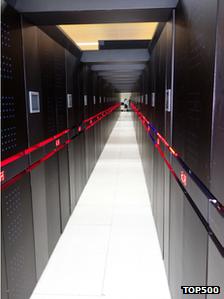China's Tianhe-2 retakes fastest supercomputer crown
- Published
- comments

A China-based supercomputer has leapfrogged rivals to be named the world's most powerful system.
Tianhe-2, developed by the government-run National University of Defence Technology, topped the latest list of the fastest 500 supercomputers, by a team of international researchers.
They said the news was a "surprise" since the system had not been expected to be ready until 2015.
China last held the top rank between November 2010 and June 2011.
According to the list, the US has the world's second and third fastest supercomputers, Titan and Sequoia, while Japan's K computer drops to fourth spot.
The latest version of the twice-yearly list - which is overseen by Hans Meuer, professor of computer science at the University of Mannheim - was published to coincide with the International Supercomputing Conference in Leipzig, Germany.
Unique features
According to the Linpack benchmark, Tianhe-2 - meaning Milky Way-2 - operates at 33.86 petaflop/sec, the equivalent of 33,860 trillion calculations per second.
The benchmark measures real-world performance - but in theory the machine can boost that to a "peak performance" of 54.9 petaflop/sec.
The project was sponsored by the Chinese government's 863 High Technology Programme - an effort to make the country's hi-tech industries more competitive and less dependent on overseas rivals.
It has said it intends to install the equipment at the National Supercomputer Centre in Guangzhou, based in the country's south-eastern Guandong province, where it will be offered as a "research and education" resource to southern China.
The machine uses a total of 3.12 million processor cores, using Intel's Ivy Bridge and Xeon Phi chips to carry out its calculations.
However, the University of Tennessee's Jack Dongarra - a member of the Top 500 list team who visited the project in May - noted that many of its features were developed in China and are unique. These include:
- A custom-built interconnection network, which routes data across the system
- The inclusion of 4,096 Galaxy FT-1500 CPUs (central processing units) designed by the university - these have been installed to handle specific weather-forecasting and national-defence applications and are not included in the headline performance figures
- The use of the Kylin operating system - this Linux-based OS is named after a mythical beast known as the "Chinese unicorn", and was designed by the university to be a high-security option for users in government, defence, energy, aerospace and other critical industries
On paper the Tianhe-2's performance is nearly double that of the next computer on the list.
Titan, at Oak Ridge National Laboratory in Tennessee, clocks 17.59 petaflop/sec of performance, according to the Linpack benchmark, and a theoretical peak of 27.11 petaflop/sec.
Mr Dongarra noted that the US government is not expected to acquire another supercomputer until 2015.
Japan's Fujitsu-built K computer - which displaced China's Tianhe-1 as the world's fastest supercomputer - now comes in fourth on the Top 500 list with a Linpack benchmark performance of 10.51 petaflop/sec.
According to the survey's editors, China now accounts for 66 of the list's fastest computers, which is actually a fall from six months ago when it had 72 in the list.
The US dominates the survey with 252 systems, Japan has 30, the UK has 29, France has 23 and Germany has 19.
- Published1 April 2013
- Published12 November 2012
- Published4 December 2012